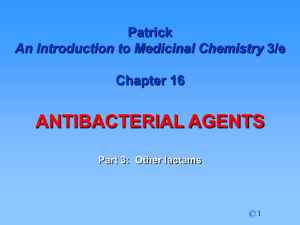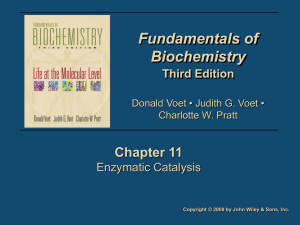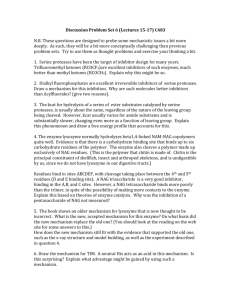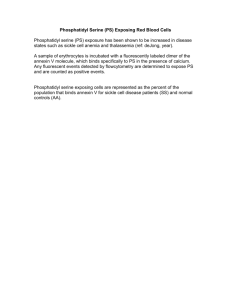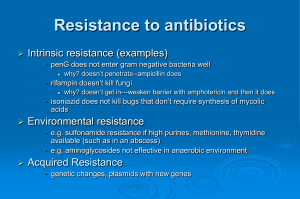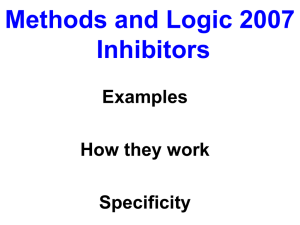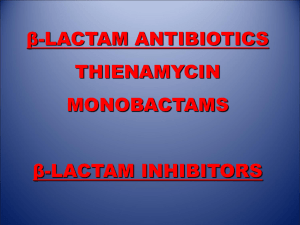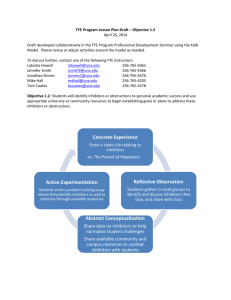Research_Presentation
advertisement
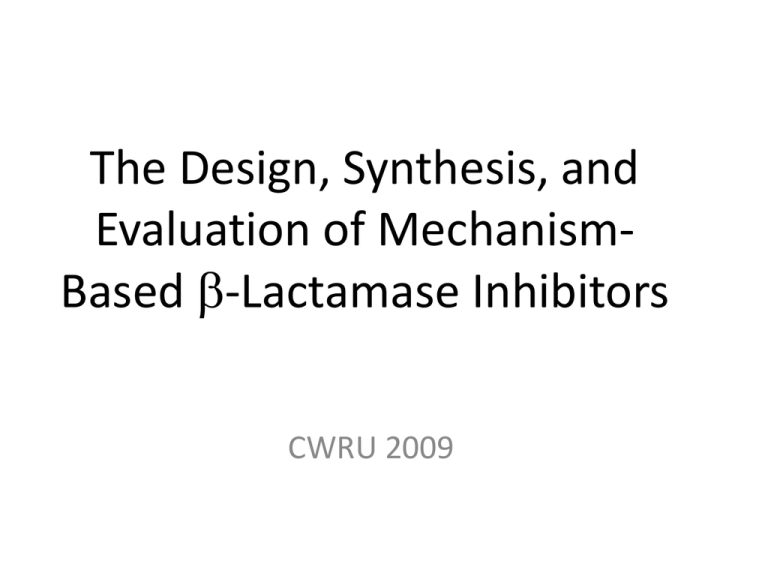
The Design, Synthesis, and
Evaluation of MechanismBased b-Lactamase Inhibitors
CWRU 2009
Major Classes of b-Lactam Antibiotics
Potent, broad-spectrum antibiotics
Usually well tolerated
Structural similarities include a negatively charged carboxylate, (usually fused
bicylic) b-lactam, and C6 appendage
The b-lactam antibiotics interfere with one or more members of a crucial set of bacterial
enzymes, known as the penicillin-binding-proteins (PBPs), that are responsible for crosslinking glycan strands through a protruding peptide side chain.
•The b-lactam antibiotics are believed to resemble the D-Ala-D-Ala terminus of the
pentapeptide side chain (Strominger Hypothesis)
•Bacterial transpeptidases cleave between the two D-Ala residues, to form an
intermediate acyl-enzyme, which is then reacted with a free amino moiety (e.g. the w
amino group of diaminopimelic acid) to form the cross link.
Blocked
Pe ptide
Chain
Blocked
H2O
O
R
C
O
H
NH
S
N
O
Me
Me
R
C
NH
H
O
HN
CO2H
OH
Link
O
Gly
O
R
S
C
NH
H
Me
O
HN
Me
CO2H
O
S
Me
Me
CO2H
Why are b-lactam antibiotics such good drugs?
•
•
•
•
•
b-Lactam antbiotics still comprise approximately half the
commercial antibiotic market.
Formation of a covalent bond to the target(s) may be an
effective strategy for avoiding resistance due to point
mutations which lower affinity
Targeting the bacterial cell wall avoids the necessity to
accumulate in cytoplasm, thus avoiding efflux pumps.
b-lactams do not penetrate most mammalian cell types,
resulting in low toxicity (disadvantage when treating atypicals)
Most commonly observed resistance is due to production of
b-lactamase(s)
Resistance to b-Lactam Antibiotics
1) Production of one or more enzymes (b-lactamases) that
hydrolytically destroy b-lactam antibiotics
2) Produce PBPs that do not recognize penicillin
3) In the case of Gram-negative strains delete outer
membrane porins, which are responsible for the allowing
the b-lactams to reach the periplasm and hence the cell
wall
4) In the case of Gram-negative strains, upregulate efflux
pumps, which are responsible for pumping out foreign
substances (including b-lactams).
Action of Serine b-Lactamases
The b-Lactamases
More than 600 different b-lactamases, grouped into four
classes A-D
• Classes A, C, and D are serine enzymes
• Class B are zinc metalloenzymes
• Historically, the class A (serine) enzymes were the most
prominent
• Can be produced in large quantity (hyperexpressed)
• Produced in the periplasm of Gram-negative organisms, or
extracellularly in Gram-positive strains.
•
O
Bulky
group
C
H
N
H
H
S
Me
R
N
Enzyme
Me
O
CO2H
•One early strategy for countering b-lactamase mediated resistance was to design blactam antibiotics which would also be poor b-lactamase substrates.
•This was achieved by incorporating sterically large substituents at C6 (penicillin) or
C7 (cephalosporin).
Methicillin-resistant Staphylococcus aureus
MRSA
•Unfortunately, this gave rise to new forms of resistance, such as the appearance
of a penicillin binding protein with reduced affinity for all b-lactam antibiotics
(PBP2a in MRSA) and also the appearance of b-lactamases with enlarged active
sites (extended spectrum b-lactamases or ESBLs) that could accommodate the
larger antibiotics.
Recent Trends in b-Lactamase-mediated
Resistance
• Broad spectrum b-lactamases, known as extended
spectrum b-lactamases (ESBLs) capable of hydrolyzing third
generation cephalosporins, are disseminated widely (e.g.
class A, CTX-M)
• Class C b-lactamases (AmpC) are more widely
disseminated, now including many plasmid-mediated
AmpCs (e.g. FOX and CMY)
• Classes A and D enzymes have evolved the ability to
hydrolyze the carbapenem class of antibiotics. These
serine carbapenemases are increasingly widespread (e.g.
KPC).
• Class B metallo-b-lactamases are disseminating widely.
These enzymes were originally seen in Asia and in Europe,
but cases of resistance due to class B b-lactamases are now
appearing in the US (e.g. IMP and VIM).
Current Commercial b-Lactamase
Inhibitors
•A second approach was to develop inhibitors of b-lactamase
•Unfortunately, current commercial inhibitors target only class A enzymes
Since the inhibitors have no independent antibacterial activity (i.e. ability to bind
PBPs), they must be coadministered with b-lactam antibiotics
How do these commercial inhibitors work?
•Placing sulfur at the sulfone oxidation state predisposes the thiazolidine ring to
fragment, producing the iminium ion shown above.
•The iminium ion can then tautomerize to the b-aminoacrylate, or be captured by a
second active site serine, producing in both cases, a stabilized acyl-enzyme.
How can we build a better mousetrap?
Irreversible inhibitors offer numerous opportunities for improving the inhibitory
efficiency.
The Inhibitor Design Process
enzymatic
mechanism
active site
dimensions and
binding
characteristics
generate a library of
prospective inhibitors
Assay against
all relevant
enzymes
synthetic feasibility
Initially we focused on designing inhibitors which held the
potential to quickly form very stable acyl-enzymes.
Focus Here
IC50 Values against the class C b-lactamase derived from Enterobacter cloacae, strain
P99
Further mechanistic investigations uncovered an isotope effect on the rate of
inactivation. A mechanism consistent with this observation is shown below.
Stabilized
Acyl-Enzyme
New chemical methodology facilitated the preparation of new inhibitors.
The availability of 6-oxopenicillanate simplifies the synthesis of 6alkylidene penams, as shown.
Table 1. Inhibitory activity on Three Representative Serine b-Lactamases IC50 (mM)
R1
R2
P99
TEM-1
PC1
None (Tazo)
CH2C2H2N3
51.9
0.297
2.57
CO2Na
CH3
4.50
1.8
108
CO2Na
CH2O2CCH3
0.708
0.180
76.53
CO2Na
CH2O2CCH2Cl
NT
0.196
7.2
CO2Na
CH2O2CH
0.592
1.84
173
CO2Na
CH2O2CCH2Ph
0.54
0.0154
579.0
CO2Na
CH2O2CCH23’,4’-C6H3(OH) 2
0.37
0.105
116
CO2Me
CH2O2CCH3
9.51
2.72
NT
CO2NH2
CH2O2CH3
8.48
0.31
2.21
CO2Na
CH2Cl
527.0
120.5
2100
CO2Me
CH2Cl
13.91
44.51
432
CO2Na
CH=CHCN
6.76
21.67
504
CO2Na
CH2O2CCH2-S-tet
0.64
0.233
NT
CO2Me
CH2O2CCH2-S-tet
13.2
2.37
939.7
a’-pyr
CH2O2CCH3
0.062
0.004
0.66
a’-pyr
CH2O2CCH2Ph
0.001
0.04
a’-pyr
CH2O2CCH2-3’,4’-C6H3 (OH) 2
0.026
0.06
0.39
0.7
Buynak, J. D. et. al. BMCL 1999, 9, 1997-2002.
Piperacillin
PIP:TAZ
PIP:JDB/LN-1-255
>64
16
2
A. sobria ((Asb A, OXA-12, AsbM)
64
64
1
S. marcescens GC 4132 (Amp C, in vivo)
64
32
4
E. coli C600N (no b-lactamase)
2
2
1
E. coli C600N +(TEM-1)
>64
4
2
E. coli C600N + (IRT – 2)
>64
8
2
E. coli C600N + (SHV – 4)
>64
2
2
E. coli C600N + (PSE – 1)
32
1
2
E. coli C600N + (OXA-10) {PSE-2}
>64
2
2
E. coli C600N + (MIR-1)
64
8
8
E. coli C600N + (Imi-1)
>64
16
8
E. coli 300 + (TEM-1)
>64
4
1
E. coli 300 + (ampRampC)
16
4
2
K. Pneumoniae KC 2 (TEM-10)
>64
2
4
E. coli GC6265 (TEM-1, in vivo)
>64
4
4
P. aeruginosa Ps505A1 (AmpC derepressed)
Inhibition of Representative b-lactamases (IC50, mM)
Inhibitor
TEM-1
AmpC
AmpC
OXA-40
E. Coli
P. aeruginosa
A. baumannii
A. baumannii
In serum
AmpC P. aeruginosa
JDB/SA-3-18
0.0004
0.008
0.017
0.0060
0.012
JDB/SA-4-11
0.00010
0.185
0.191
0.191
0.028
JDB/SA-4-17
0.00003
0.012
0.020
0.007
0.014
JDB/SA-4-141
0.0002
0.065
0.071
0.583
0.029
JDB/SA-4-157
0.0006
0.201
0.515
0.888
0.080
JDB/SA-4-196
0.0001
0.006
0.015
0.046
0.003
JDB/SA-4-198
0.0001
0.039
0.052
0.079
0.015
JDB/LN-1-255
0.00003
0.006
0.004
0.011
0.082
Synergy of Inhibitors with Imipenem Against Resistant P. aeruginosa
Imipenem
(mg/L)
JDB/SA3-18
(mg/L)
JDB/SA4-11
(mg/L)
JDB/SA4-17
(mg/L)
JDB/SA4-141
(mg/L)
JDB/SA4-157
(mg/L)
JDB/SA4-196
(mg/L)
JDB/SA4-198
(mg/L)
JDB/LN1-255
(mg/L)
MIC
20
0
0
0
0
0
0
0
0
0.5 MIC
10
12.5
25
25
12.5
3.125
6.25
12.5
6.25
0.25 MIC
5
100
50
50
25
12.5
12.5
25
25
0.125
MIC
2.5
100
100
100
25
25
12.5
50
50
0.0625
MIC
1.25
>100
>100
>100
50
50
25
100
100
0.0313
MIC
0.625
>100
>100
>100
>100
>100
>100
>100
>100
Inhibition of b-Lactamase (IC50 mM)
R
Escherichia coli W3310
(Class A)
Enterobacter cloacae P99
(Class C)
t-butylmethylidene (allene)
>2000
11.8
a-pyridyl
44
1.30
CO2But
0.28
429
tazobactam
1.37
51.9
clavulanic acid
3.3
>2000
Initial attempts to improve the cephalosporin series of b-lactamase inhibitors relied
on analogy with the cephalosporin antibiotics themselves.
But these efforts resulted in an abysmal failure!
•Since the charge neutral pyridine moiety is a better leaving group than the
negatively charged acetate, it is more likely to follow pathway 1 above.
•Yet all the inhibitory mechanisms we have proposed follow pathway 2.
Type
R1
R2
Tazo
TEM-1
PC1
P99
GC1
0.32
2.8
49.8
3.4
I
2’-py
E-CH=CH-CN
0.014
0.72
0.01
0.012
I
2’-py
E-CH=CHCO2Me
0.02
0.30
0.20
0.30
I
2’-py
E-CH=CHCONH2
0.09
0.10
0.026
0.01
I
2’-py
Z-CH=CClCO2Me
0.07
1.4
0.90
0.18
I
2’-py
E-CH=CH-CH=CH2
68
75
24
NT
I
2’-py
E-CH=CHCO2But
NT
240
1.48
NT
I
2’-py
E-CH=CHCO2Na
2.5
31
0.31
NT
I
2’-py
E-CH=CHNO2
0.07
0.20
0.02
0.10
I
2’-py
E-CH=CH-2’-py
0.20
4.3
0.18
NT
I
2’-py
E-CH=CH-2”py-N-ox
0.006
8.6
0.60
0.10
I
2’-py
CN
2.34
280
0.029
NT
I
2’-thzl
E-CH=CHCONH2
0.90
154
0.29
NT
II
2’py
E-CH=CHCO2Me
2.9
6.0
0.03
0.06
II
2’-py
E-CH=CH-CO2But
NT
NT
440
150
II
2’-py
E-CH=CHCO2Na
2.5
NT
6.60
NT
R
TEM-1 Inhibition
IC50, mM
P99 Inhibition
IC50, mM
Tazobactam
0.25
101.6
CH=CH-CONH2
0.2615
0.022
CH=CH-CONHCH2CF3
0.078
1.18
CH=CH-CONHCH2CH2OH
0.0701
0.212
CH=CH-CONHCH(CH2) 2
0.240
0.824
CH=CH-CONH-CH2CH2 (CN3H4)
0.0083
0.0055
CH=CH-CONHOH
7.69
0.128
CH=CH-CONHC6F5
4.28
0.127
CH=CH-CON(CH2CH2) 2NMe
0.053
6.34
CH=CH-CONHCH 2Ph
1.4
0.11
CH=CH-CONHNH 2
0.39
1.1
CH=CH-CO-NHC 6H4OH
0.11
0.035
CH=CH-CONHCH 2CO 2Na
4.2
0.31
CH=CH-CONH(CH 2) 3NH 2
1.59
4.2
How do my inhibitors work?
• Intramolecular capture of intermediate imine is more efficient than intermolecular
capture (and/or tautomerization)
• Inhibitors tend to be more general to all (serine) b-lactamases, since inhibitory
mechanism does not depend on enzyme active site groups
Next goal: Prepare penicillin-derived inhibitors of metallob-lactamases
Problem: Metallo-b-lactamases are still a small portion of
total number of b-lactamase producing strains
Solution: Prepare a single molecule that can function as dual
inhibitor of both metallo- and serine-b-lactamases.
Problem: Metallo and serine b-lactamases have profoundly
different mechanisms of action.
Proposed series of events involved in the hydrolysis of a cephalosporin substrate by
the L1 metallo-b-lactamase.
Inhibiting metallo-b-lactamases
Like most metalloenzymes, metallo-b-lactamases are inactivated by good zinc
chelators.
Potential problem is that zinc chelating agents would likely be nonspecific, thus
resulting in toxicity.
Solution: Generate a zinc chelating moiety that relies on the action of the enzyme
itself to achieve optimal inhibitory activity (i.e. generate a mechanism-based
metalloenzyme inhibitor).
Proposed Mechanism-based Inhibitors of the Zinc Metallooenzymes
Inhibition of Serine and Metallo-b-lactamases
IC50 (mM)
Compound
TEM-1
(class A)
(Serine)
P99
(class C)
(Serine)
L1
(class B)
(Metallo)
BCII
(Class B)
(Metallo)
Tazobactam
0.122
53.2
>200
>200
752
409
>200
>200
275
96.2
>200
>200
0.65
3.9
72.3
>200
14.6
10.0
>200
>200
Inhibition of Serine and Metallo-b-lactamases
Tazobactam
IC50 (mM)
TEM-1
(class A)
(Serine)
P99
(class C)
(Serine)
L1
(class B)
(Metallo)
BC1
(Class B)
(Metallo)
0.122
53.2
>200
>200
601
0.10
32.1
2.9
648
3.75
10.9
1.7
6.8
10.5
0.10
1.4
51.7
7.5
0.30
2.0
Van den Akker Strategy: Stabilize the E-b-aminoacrylate
intermediate in the active site.
Focus Here
Focus Here
•Designed by analogy with acyl-enzyme of Tazobactam.
•This should result in an acyl-enzyme with increased affinity for the site.
•May retain occupancy of the site subsequent to hydrolysis of the covalent
ester linkage of the acyl-enzyme.
Design a 2’-substituent that stabilized the E-form of the b-aminoacrylate
Thanks to my collaborators:
Robert Bonomo
Paul Carey
Marion Helfand
Focco van den Akker
And my funding sources:
Robert A. Welch Foundation
National Institutes of Health
